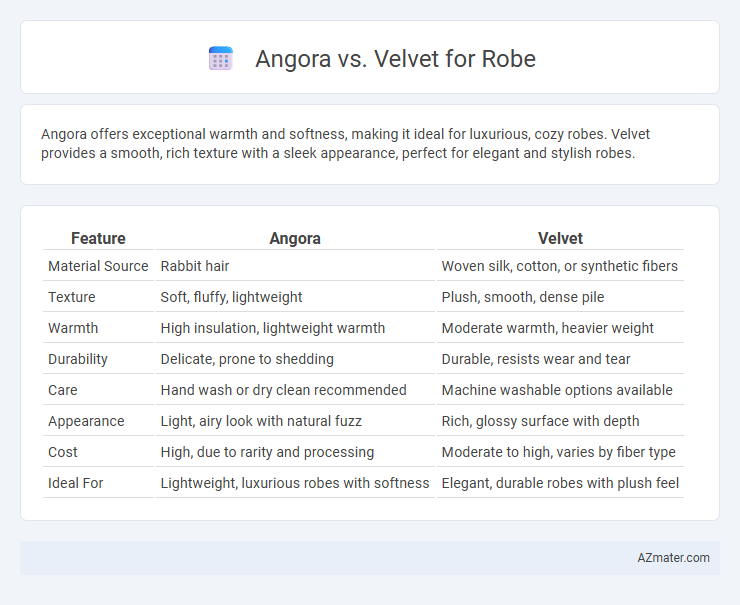Angora offers exceptional warmth and softness, making it ideal for luxurious, cozy robes. Velvet provides a smooth, rich texture with a sleek appearance, perfect for elegant and stylish robes.
Table of Comparison
| Feature | Angora | Velvet |
|---|---|---|
| Material Source | Rabbit hair | Woven silk, cotton, or synthetic fibers |
| Texture | Soft, fluffy, lightweight | Plush, smooth, dense pile |
| Warmth | High insulation, lightweight warmth | Moderate warmth, heavier weight |
| Durability | Delicate, prone to shedding | Durable, resists wear and tear |
| Care | Hand wash or dry clean recommended | Machine washable options available |
| Appearance | Light, airy look with natural fuzz | Rich, glossy surface with depth |
| Cost | High, due to rarity and processing | Moderate to high, varies by fiber type |
| Ideal For | Lightweight, luxurious robes with softness | Elegant, durable robes with plush feel |
Introduction to Angora and Velvet Fabrics
Angora fabric, derived from the Angora rabbit, is renowned for its exceptional softness, lightweight warmth, and luxurious texture, making it a premium choice for robes. Velvet, a weave characterized by its dense pile and lustrous surface, offers a rich, smooth feel with excellent insulation and a dramatic, elegant appearance. Both fabrics differ significantly in fiber origin and tactile qualities; Angora is a natural animal fiber prized for its thermal properties, while velvet can be made from various fibers such as silk, cotton, or synthetic blends, emphasizing its versatility and sheen.
Key Differences Between Angora and Velvet
Angora robes are prized for their exceptional softness and lightweight warmth, derived from the fine fibers of Angora rabbits, providing natural insulation and breathability. Velvet robes offer a luxurious, dense fabric with a smooth, rich texture made from woven silk, cotton, or synthetic fibers, known for durability and elegant sheen. The key differences lie in Angora's natural, fluffy fiber composition that excels in warmth without bulk, while velvet emphasizes heavyweight opulence and a plush, glossy surface.
Texture and Feel: Angora vs Velvet
Angora offers a soft, lightweight, and airy texture with a delicate, fluffy feel that provides luxurious warmth, making it ideal for robes designed for comfort and coziness. Velvet boasts a smooth, dense pile with a plush, rich texture that feels opulent and silky against the skin, creating a sophisticated and elegant tactile experience. The choice between Angora and Velvet for robes hinges on whether you prefer the light, fuzzy softness of Angora or the sleek, lustrous smoothness of Velvet.
Warmth and Insulation Properties
Angora fibers provide exceptional warmth and superior insulation due to their hollow core, which traps air efficiently, making angora robes ideal for cold climates. Velvet, while plush and soft, does not offer the same level of thermal retention because it is typically made from densely woven fibers that lack the natural insulating properties of angora. Choosing an angora robe ensures enhanced heat retention and lightweight comfort, whereas velvet robes prioritize luxurious texture over maximum warmth.
Durability and Longevity Comparison
Angora robes offer exceptional softness but tend to be less durable due to the delicate nature of mohair fibers, requiring careful handling and maintenance to extend longevity. Velvet robes, crafted from densely woven fibers like cotton or silk blends, provide superior durability and resist wear better over time, making them ideal for long-term use. When comparing durability and longevity, velvet robes consistently outperform angora, maintaining structural integrity and appearance through frequent wear and washing.
Care and Maintenance Requirements
Angora robes demand gentle care, including hand washing in cold water and drying flat to maintain their soft texture and prevent fiber damage. Velvet robes require professional dry cleaning or delicate washing cycles to preserve their luxurious pile and prevent crushing or color fading. Both fabrics benefit from careful storage away from direct sunlight and moisture to enhance longevity and maintain their plush appearance.
Style and Aesthetic Appeal
Angora robes offer a luxurious, soft texture with a natural sheen that elevates elegance and warmth, making them ideal for a classic, sophisticated aesthetic. Velvet robes showcase a rich, plush surface with deep color saturation, providing a dramatic and opulent style perfect for bold, glamorous looks. The choice between Angora and Velvet robes ultimately depends on the desired visual impact, balancing subtle refinement and tactile richness.
Skin Sensitivity and Comfort
Angora fiber is renowned for its exceptional softness and warmth, making it ideal for individuals with sensitive skin due to its hypoallergenic properties and fine texture that minimizes irritation. Velvet, often crafted from silk, cotton, or synthetic fibers, offers a smooth and luxurious feel but may vary in breathability and softness depending on its material composition, which can affect comfort for sensitive skin. Choosing angora robes typically enhances comfort for those prone to skin sensitivities, while velvet robes provide a plush aesthetic that may require careful selection of the base fabric to ensure skin-friendly wearability.
Price and Value for Money
Angora robes tend to be more expensive due to the high cost of sourcing soft, luxury Angora wool, offering excellent warmth and a plush feel that justifies the price for premium comfort. Velvet robes, while generally more affordable, provide a rich appearance and smooth texture but may not offer the same insulating properties or durability as Angora. Choosing between Angora and Velvet robes depends on whether the priority is superior warmth and softness or a cost-effective option with elegant aesthetics.
Choosing the Right Fabric for Your Robe
Angora offers exceptional softness and warmth, making it perfect for luxurious, cozy robes that provide superior insulation during colder months. Velvet, known for its smooth texture and elegant sheen, creates robes with a sophisticated appearance while remaining breathable and comfortable for year-round use. When choosing the right fabric for your robe, consider Angora for maximum warmth and plushness, or Velvet for a stylish, lightweight option that balances comfort with refinement.

Infographic: Angora vs Velvet for Robe
 azmater.com
azmater.com